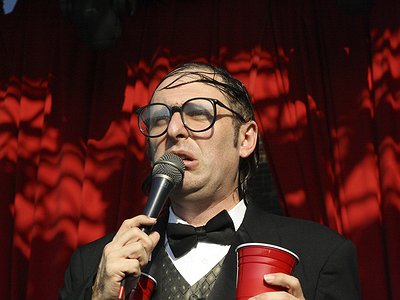Part 1
Name: Neil Hamburger (AKA Gregg Turkington)
Nationality: American/Australian
Occupation: Comedian/Musician
Current Release: Still Dwelling on Drag City
Recommendations: I would suggest listening to the song “Feel Like Giving Up” by Paul Williams of The Temptations/ “Watertown” by Frank Sinatra, which is my very favorite and really inspired us to make this new album.
Website/Contact: Visit Neil's website www.americasfunnyman.com for tour dates or to book the man himself for your next event.
When did you start writing/producing music - and what or who were your early passions and influences? What is it about music and/or sound that drew you to it?
I mainly make spoken-word, comedy records, but we’ve had songs on the records since the very beginning. I think the first one I recorded was called “She Sits Among The Cabbages And Peas”. You know, the key to success is being a well-rounded entertainer. Jokes are my trade, but it can’t hurt to have a little song-and-dance up the sleeve as well. Jerry Lewis opened all his shows with a song. And conversely, the great singers would always throw in a joke or two in the midst of their set. But more recently I’ve tried to steer clear from songs that might be categorized as a “novelty” and instead find numbers that reflect some of the sadder themes touched upon in the act.
For most artists, originality is first preceded by a phase of learning and, often, emulating others. How would you describe your own development as an artist and the transition towards your own voice? What is the relationship between copying, learning and your own creativity?
It’s good to absorb the commitment to entertain, the honest commitment to putting on a quality show that the greats all had. But for god’s sake, you cannot pinch the specifics of their styles. That’s poisonous! You need to figure out what your personal point of view is, and then throw it up onto the stage every night.
What were your main compositional- and production-challenges in the beginning and how have they changed over time?
I cannot play the piano. But I know what I like. No one is going to convince me to cover a Foghat song. I had a lot of discussions with my producer on Still Dwelling, Erik Paparozzi, to figure out how we could make the best record that we could make. He can play anything! Just to add some additional “spice” to the mix, we brought in some pals to throw in their two cents, musically speaking. We contacted the folks that were right for these particular songs. Obviously, you don’t want to bring in druggies. Or someone with a bad flu.
What was your first studio like? How and for what reasons has your set-up evolved over the years and what are currently some of the most important pieces of gear for you?
I don’t have a studio. I have stayed in motel or hotel rooms that are advertised as “studios” but it’s just another name for a single, solitary room with a bed and perhaps a desk. I have my own microphone that I travel with, and we used it on this record too. It was made by the Sennheiser people. I bought it in Australia several years ago in the midst of a long run of shows at the Portland Hotel in Melbourne. I broke my other microphone dropping it on the floor in disgust with the way that particular night was going.
How do you make use of technology? In terms of the feedback mechanism between technology and creativity, what do humans excel at, what do machines excel at?
Humans excel at telling jokes and singing; machines excel at perhaps documenting that. It’s crazy when these “dance music” assholes use their stupid laptop computer to do the lead vocals. What a nightmare sound that is! People complain that I might not be on the level of a Bing Crosby or Rudy Vallee on the vocals, but I’ll tell you, at least I’m making an effort to produce a relatable sound. The last thing I want to hear is some dumb computer voice singing about how to live my life.
Production tools, from instruments to complex software environments, contribute to the compositional process. How does this manifest itself in your work? Can you describe the co-authorship between yourself and your tools?
If the computer tools can record what’s going on, I salute them. Especially if they can do it in a way that’s easy and imperceptible. But there was plenty of great music before those tools appeared. They add as much to the sound as a digital display on an oven adds to a great casserole. As for the musical instruments—we used a lot of them on this record; trombones, trumpets, cellos, violins, vibraphone, you name it! Heavy to carry around, but well worth it. The musicians really put themselves into what they play, and their personality shines through. And it’s a pleasure to spend time around these people. Computers—half the time I’m ready to throw them into the trash.
Collaborations can take on many forms. What role do they play in your approach and what are your preferred ways of engaging with other creatives through, for example, file sharing, jamming or just talking about ideas?
I loved working with Erik Paparozzi on this record. We were on the same page about what we wanted, and what we wanted to avoid. I would not want to work with a jerk; like the guys from Papa Roach, or Gene Simmons, or some of the slovenly no-name rockers that have approached me over the years…
Could you take us through a day in your life, from a possible morning routine through to your work? Do you have a fixed schedule? How do music and other aspects of your life feed back into each other - do you separate them or instead try to make them blend seamlessly?
I have a lot of shows to do. On the road, all the time. We recorded this record in a number of studios worldwide, but mostly in Los Angeles and Las Vegas. I generally skip breakfast. Or would eat a handful of fruit. Mostly it’s a lot of driving. Definitely the mood of this type of lifestyle infected the vocal performance on a lot of those songs.






